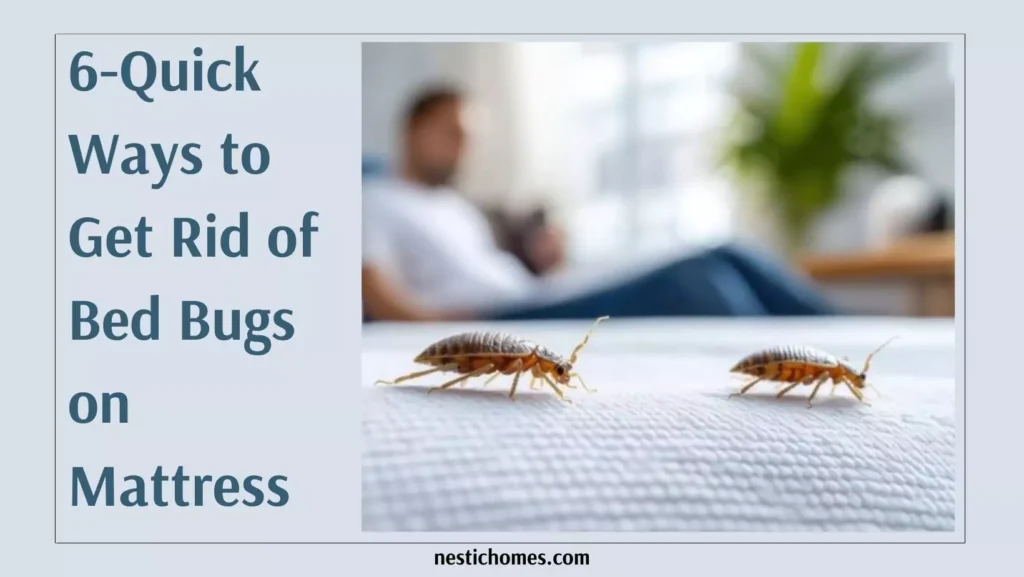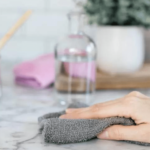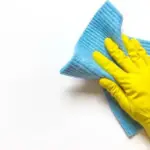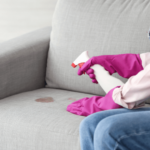Bed bugs. Those two words alone can send a shiver down your spine. No one wants them, yet these tiny, elusive creatures can find their way into even the most pristine homes and the cozy haven of your mattress is one of their favorite hangouts.
If you find bed bugs on your mattress (yikes!), don’t panic. We got you! Our editors learned a lot about the bed bugs and finally, we can explain how to get rid of bed bugs on mattress, prevent re-infestations, and restore your sleeping space to its rightful, tranquil state.
What Are Bed Bugs, and Why Do They Love Mattresses?
Bed bugs are tiny, reddish-brown insects that survive by feeding on the blood of humans or animals. They’re often compared to the size of an apple seed, making them notoriously hard to spot at first glance. But don’t be fooled by their size bed bugs are tenacious and can multiply at an alarming rate.
Why mattresses?
Simply put, your mattress offers everything a bed bug could dream of (pun intended): warmth, proximity to their food source (you!), and plenty of hiding spots in seams, tufts, and folds. They’re experts at staying hidden during the day and emerging at night just when you’re trying to get a peaceful night’s sleep.
RELATED BLOG
- 15 Bugs That Look Like Bed Bugs And How to Get Rid of Them
- How to Get Rid of Bed Bugs ,Home Remedy by Experts Tips
6 Steps to Get Rid of Bed Bugs on Mattress
1. Confirm that it’s actually a bed bug
- Red or rust-colored stains on your mattress (from crushed bugs).
- Black specks (their droppings) in seams and folds.
- Small eggs or shed skins. Eggs resemble tiny grains of rice.
- Bite Marks on your skin in a line or cluster, particularly after sleeping.
2. Strip, Wash, and Heat-Dry Your Bedding
Remove all bedding, including sheets, pillowcases, blankets, and mattress protectors. Wash these items immediately in hot water—be sure your water temperature is at least 120°F (49°C)—then dry them on high heat for at least 30 minutes. Heat is lethal to bed bugs and their eggs, so don’t skip the drying step.
Pro Tip from Pest Control Experts:
“Heat treatments are one of the most effective ways to kill bed bugs. Bed bugs cannot survive temperatures above 120°F,” says Dr. Michael Potter, a noted entomologist specializing in pest control.
3. Vacuum Your Mattress Thoroughly
Once your bedding is out of the way, get to work on the mattress. Use the hose attachment of your vacuum to clean every inch of the surface, paying special attention to seams, crevices, and tufts where bed bugs love to hide.
Key Tips for Vacuuming Effectively:
- Use a stiff brush to loosen any eggs or fecal matter clinging to the fabric.
- Immediately empty the vacuum outside into a sealed plastic bag to prevent reinfestation.
4. Other ways to get rid of bed bugs on mattress
There are two main treatment options—natural remedies or professional-grade solutions.
Natural Options:
- Steam Cleaning: A handheld steamer can be incredibly powerful. Direct a stream of high-temperature steam (above 120°F) onto every corner, seam, and edge of your mattress.
- Diatomaceous Earth: Sprinkle this natural powder (made from crushed fossils) along your mattress seams and cracks. It dehydrates and kills bed bugs over time.
Chemical Solutions:
Several EPA-approved sprays, such as Steri-Fab or EcoRaider, are specifically designed to target bed bugs. Ensure you follow the label instructions carefully and allow your mattress to air out before using it again.
“It’s important to keep safety in mind when using insecticides,” advises pest management professional Susan Jones. “Look for products with active ingredients that are proven effective, but consider consulting a specialist for guidance.”
5. Seal Your Mattress with an Encasement
After treatment, a mattress encasement is your new best friend. These zippered covers encase your entire mattress and act as a barrier to prevent any remaining bed bugs from escaping or re-infesting. Invest in a high-quality, bed-bug-proof encasement and leave it on for at least a year to ensure complete eradication.
Bonus Benefit: Mattress encasements can also protect your mattress from spills, allergens, and future infestations.
6. Eliminate Hiding Spots
Bed bugs are opportunistic and will look for dark, cozy spaces once their favorite mattress spot is no longer an option. Declutter your bedroom, repair cracks in walls or furniture, and avoid storing items under the bed. These proactive steps will make your entire space far less appealing to bed bugs.
FAQs
How can I identify bed bugs on my mattress?
Look for these common signs on your mattress to confirm a bed bug infestation:
- Red or rust-colored stains caused by crushed bed bugs.
- Black specks, which are their droppings, in seams or folds.
- Tiny, rice-like eggs or shed skins near mattress crevices.
- Bite marks on your skin, often in a line or cluster, especially after sleeping.
What is the most effective way to treat bed bugs on a mattress?
Follow these essential steps for effective treatment:
- Strip bedding and wash it on high heat (120°F) to kill bugs and eggs.
- Vacuum the mattress thoroughly, paying close attention to seams and tufts.
- Use steam cleaners or natural powders like diatomaceous earth as chemical-free options.
- Consider EPA-approved sprays for targeted treatment but follow instructions carefully.
Are chemical sprays safe to use on mattresses?
Yes, if used correctly. Always choose EPA-approved products and follow the label directions for safe application. Allow the mattress to fully air out before sleeping on it and consider consulting a pest control professional for guidance.
Do I need to replace my mattress after treating bed bugs?
Not necessarily. If treated thoroughly and sealed with a high-quality bed bug-proof mattress encasement, your mattress can often be salvaged. Encasements trap any remaining bugs and prevent reinfestation.
How can I prevent bed bugs from returning?
Reducing the chances of reinfestation is key. Here’s how:
- Use a mattress encasement to create a barrier.
- Declutter your bedroom and avoid storing items under the bed.
- Repair cracks in the walls and furniture to eliminate hiding spots.
- Inspect secondhand furniture, luggage, or clothing before bringing them into your home.
Are heat treatments effective for bed bugs?
Yes, heat is one of the most effective solutions. Bed bugs and their eggs cannot survive temperatures above 120°F. Washing and drying your bedding on high heat and using steam cleaners are excellent heat-based methods.
What are the signs of reinfestation?
Keep an eye out for the same indicators as before, such as rust-colored stains, droppings, or bite marks. If any signs reappear, repeat treatment immediately and reassess preventive measures to stop new infestations.







